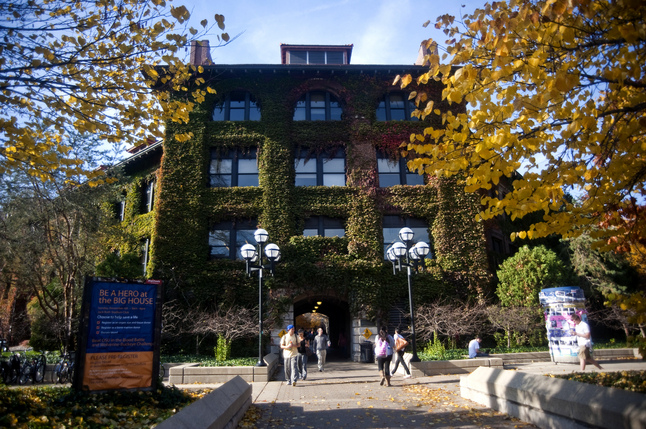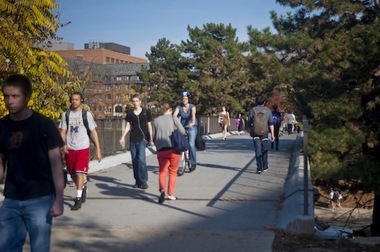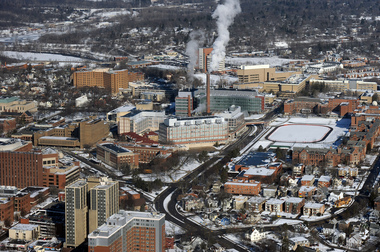46,730 applications: University of Michigan expects roughly 6,000 freshmen to enroll in the fall

Students traverse the University of Michigan's Ann Arbor campus.
Joe Tobianski | AnnArbor.com
Correction: The figuring representing U-M's acceptance rate has been fixed. U-M accepted approximately 1/3 of applicants.
The University of Michigan received more than 46,730 applications for entry to its 2013 freshman class- and 33 percent of applicants were admitted.

University of Michigan's campus
Joseph Tobianski | AnnArbor.com
The uptick in applications marks a 10 percent increase over last year, when the school received 42,480 submissions. The year before, in 2011, U-M received 39,570 applications.
The increase is due in part to U-M's growing international profile and also its switch to the Common Application in 2010. The Common Application allows students streamline their college application process and submit near-identical applications to participating schools, provided applicants tailor personal essays for each school.
U-M said this year is the seventh consecutive year the number of applications has broken the previous record.
Final enrollment figures will be available in October.

University of Michigan's downtown Ann Arbor campus.
Melanie Maxwell I AnnArbor.com
U-M enrolled about 6,170 freshmen this year, down from roughly 6,250 in 2011 and 6,500 in 2010.
The school's sweet-spot for freshmen enrollment is just under 6,000 students.
"Most of our applicants are qualified to be U-M students. Our job in admissions is to select from this amazing applicant pool the best possible freshman class — students who will flourish at the university and also complement the community as a whole during their years here," Ted Spencer, associate vice provost and executive director of the Office of Undergraduate Admissions, said in a release.
Kellie Woodhouse covers higher education for AnnArbor.com. Reach her at kelliewoodhouse@annarbor.com or 734-623-4602 and follow her on twitter.


Comments
JRW
Thu, May 23, 2013 : 8:30 p.m.
With a common application it's too easy to fill out one app and check the boxes for applying to a couple dozen colleges. I think a lot of these 47,000 applicants aren't really serious about UM. Some just want to see if they can get in, and others are using it as a back-up school for the other dozen or so they really want to attend. Too bad there is no way to weed out these apps and not use staff time in reviewing them.
blue85
Thu, May 23, 2013 : 9:17 p.m.
JRW: your theory is reasonable, but consider the following: 1) before the UM switch to the common app., the yield was around 40%-44%; 2) with the new application, the yield hasn't really budged; 3) getting the same yield out of an increased pool suggests that while what you are saying is logical it doesn't seem consistent with the steady yield; 4) it seems that UM is getting more and more out of state applicants (despite a fairly steady 35% to 40% representation), so with yield steady and uptake steady, that would suggest that the increase in applications will allow UM to not only hold steady, but possibly upgrade entrance statistics. As to not wasting staff time, I think there is a lot of "self-selection" in applications, even with new application: people usually choose a match, a reach, and a safety...given what they know about their own metrics, they are probably already spanning 1 standard deviation of probable admittance institutions. If so, then the spanning set they choose will be fairly stable. The only thing that will probably move the needle much is the ongoing money versus accessibility issue.
a2trader
Thu, May 23, 2013 : 5:38 p.m.
Perhaps next year the University will increase its admissions staff to review this growing number of applications in a timely manner. It was my understanding that some students who applied within the University's timeline to receive their early acceptance/rejection letter, instead received "deferred" letters until the University had time to actually review their applications. Since "deferred" in past eras meant thanks-but-no-thanks, all these poor kids thought they were essentially rejected. Only later did they find out that the deferrals were because the University hadn't had time/staff to review. I know at least of few kids who were so put off by the early so-felt rejection, they decided to go elsewhere even though they were eventually admitted.
blue85
Thu, May 23, 2013 : 6:34 p.m.
This is a university-side blunder that has been evident in prior years. For a school as well run as UM, the applicant review cycle is an embarrassment. Granted, there are some growing pains with the new application process, but UM needs to be much more timely in order to be fair to the kids that need to look elsewhere, or who have an admission, but need to know UM's posture before committing a deposit. Message boards -- over the last 5 years or so -- indicate that this is and continues to be a black eye for UM.
Kyle Mattson
Thu, May 23, 2013 : 5:02 p.m.
Congrats to all the students who were/will be admitted for the upcoming school year. Here's a great video I stumbled upon that shows the true excitement that some of these students have when they find out their hard work in high school has paid off: http://bit.ly/10q4wFY
Aah
Thu, May 23, 2013 : 4:13 p.m.
What percent of those accepted are from Michigan??
skm
Thu, May 23, 2013 : 3:58 p.m.
How is the 42% computed? 15430 acceptances out of 46730 applications is more like 33%
Cindy Heflin
Thu, May 23, 2013 : 4:02 p.m.
SKM: That information has be corrected in the story. The acceptance rate is 33 percent.
pooh bear
Thu, May 23, 2013 : 3:57 p.m.
what percent of those accepted are from Michigan?
blue85
Thu, May 23, 2013 : 9:11 p.m.
Of the kids accepted, the yield is 70%. The matriculants from in state have been running around 65% of the class. With a yield of 70%, roughly 3900 chose to attend, and roughly 1600 choose to not attend, opening up seats for out of state and international. Note that those in state students who say no run in a roughly 60% yes to 40% no ratio...similar to the ratio of in and out of state matriculants.
what4
Thu, May 23, 2013 : 3:49 p.m.
Say, whatever happened to that promise to keep non-Michigan undergraduate enrollment at 30%, last fall it was 38%. A lot of Michigan residents who deserve an education at the state's "flagship" institution are not getting that opportunity. Beyond that the University 10years ago was quite aggressive holding the entering Freshman class to 4,300 or so, now we've been running at over 6,000. So many more undergraduates who are far more likely to be high paying out-of-state students. Oh I get it, the institution is actually a money machine to provide bloated salaries the uberliberal faculty teaching the children of wealthy liberals from all over the country. If your are a bright child of a conservative farmer in the state you are simply out of luck.
blue85
Thu, May 23, 2013 : 9:06 p.m.
"The state can't have it both ways:" Agreed. This is a conservative state with conservative values. Therefore state residents should only want to get what they pay for. Given a cost far in excess of the $38,000/year or so that is typically quoted, but using $38,000 just for fun, a $325MM contribution by the state would suggest 8552 "seats" or roughly 35% of each entering class ((8552/4)/6000). In other words, the ratio should be flipped to 65% out of state and 35% in-state.
JRW
Thu, May 23, 2013 : 8:38 p.m.
The instate/out of state admission ratio is a contentious issue at the state level. The state dollars to UM are dwindling every year, and only represent about 15% of the operating budget. UM is barely a "state" funded school. Yet, the legislature likes to make demands that a high percentage (roughly 2/3) of admissions come from instate. UM is becoming a private school in terms of funding, and international students pay full out of state tuition with no financial aid, and out of state students pay much higher tuition. These are fiscal realities. What % of admissions should be from Michigan when the state gives less and less to the university is a very contentious issue. The state can't have it both ways: demand a high % of admissions from instate students who pay lower tuition and at the same time, continue to decrease funding every year from the state.
blue85
Thu, May 23, 2013 : 5:10 p.m.
With a class of roughly 6,000 and an in-state ratio of around 60%, there are roughly 3,600 students from in-state. However, and it is a big one, the in-state yield is roughly 70%. Which means that to get the 3,600 students, UM offered 5,132 in-state students. That suggests that roughly 1,500 seats in the class are, effectively, filled by students who said "No thanks" to UM. There might indeed be LESSER qualified students who would like to attend, but given the applicant pool's various strengths, UM filled the seats rejected by Michigan residents and offered them to out of state students. Out of state students pay more in tuition, and while they are, roughly, 1/3 of the class, they also contribute, year over year, 2/3 of the total alumni donations. So, in addition to spreading the university's reputation around the country and around the world, they pay more up front, and send money back home in later years. Guys like Charlie Munger are helping to fund UM so in-state residents in the future will have lower costs and greater access. It is a pretty good "trade" for the state.
samshoe
Thu, May 23, 2013 : 5 p.m.
I was a bright child of a somewhat conservative farmer in the state and I got in. I think your argument is a bit weak.
Ms1215919
Thu, May 23, 2013 : 3:47 p.m.
Your 1st sentence is misleading - 42% of 46,730 = 19,626 - and does not reflect what you meant. 33% were offered admission and 42% of THOSE were admitted. "The University of Michigan received more than 46,730 applications for entry to its 2013 freshman class - and nearly 42% of applicants were admitted." What you mean is that approximately 33%, or 15,430 of those applicants were offered admission and 6,450 - or 42% - paid an enrollment deposit.
Ms1215919
Thu, May 23, 2013 : 9:13 p.m.
As the Pure Michigan ad points out....."Ann Arbor does it up different."....... oh yeah, and with such aplomb.
Blue Marker
Thu, May 23, 2013 : 3:30 p.m.
I believe it costs around $65.00 to apply to UM. If my math is correct that's over 3 million dollars in application fees alone. Can that be right?
Evan Smith
Fri, May 24, 2013 : 2:07 a.m.
Blue Marker, That's correct. You would be surprised how resource intensive holistically analyzing nearly 50,000 applications (each of which has 4 essays) can get. Blue85, there are not several hundred readers, its much more like a couple dozen.
blue85
Thu, May 23, 2013 : 9:01 p.m.
Yes, your revenue figure is correct. Sadly, the expenses of having several hundred readers (200 to 400?) as well as other costs doubtless chew up much of that revenue. In a perfect world, as a not for profit, revenue would equal expense so it would all wash.
mightywombat
Thu, May 23, 2013 : 3:16 p.m.
Shouldn't the acceptance rate be closer to 33%? (15 / 45 = 1/3)
Kellie Woodhouse
Thu, May 23, 2013 : 3:27 p.m.
Yes, indeed. Thanks for noting. I mixed up the acceptance rate and yield rate when writing. I am appending a correction now. Thanks again!
maallen
Thu, May 23, 2013 : 2:55 p.m.
Wouldn't it be nice if the 15,430 applicants offered admission were strictly based on academics, extracirricular activites, and community involvement instead of skin color?
jim c
Tue, May 28, 2013 : 2:10 p.m.
Mighty Wombat, they did away with affirmative action and now do it based on your zip code. I know a student who had a 4.2 GPA from a college prep high school with a 33 ACT score and a western suburb zip (caucasian) - NOT ACCEPTED, and a student with a 3.3 GPA from the City of Detroit Public School system, and a 26 ACT score and a City of Detroit Zip Code ( ???) - ACCEPTED. Hmm??
E Claire
Fri, May 24, 2013 : 7:15 p.m.
So leaguebus, you assume all minorities are poor people who go to inferior schools? Many white kids are poor too and are stuck in poor school districts. Did it ever occur to you that a student who graduated, even as valedictorian, from an inferior high school may not be able to excel at Michigan?
maallen
Fri, May 24, 2013 : 1:26 p.m.
Leaguebus, An intelligent student who works hard should get a chance to go to UM. Ethnicity should play no part in it. Doesn't matter if one is blue, purple, black, orange, yellow, pink.
leaguebus
Fri, May 24, 2013 : 2:25 a.m.
So MA, an intelligent student who works hard, but goes to a school district that is broke and substandard shouldn't get a chance to go to UM? A student who's parents can't afford tutoring on the ACT or the SAT shouldn't get in? MA's world view means that only the educationally and economically privileged need apply. How sad.
JRW
Thu, May 23, 2013 : 8:26 p.m.
Not just ethnicity is taken into account. Also, legacy admissions for those with parents who attended, admissions for children of big donors, sports admissions, etc. Lots of criteria other than academics, community involvement and test scores.
blue85
Thu, May 23, 2013 : 6:30 p.m.
You are implicitly assuming that skin color as you phrase it is somehow not correlated with the other factors which you mention: academics, activities and what not. Rather than offering thoughts on generalities, why not be specific: what are the conditional expectations for an admission being offered based on the whole package? Merely seeing minorities offered tells you nothing. Seeing a higher percentage offered still tells you nothing because you don't know: percentage of population; percentage of population with equivalent merits; percentage with equivalent merit offered; percentage offered who accepted; percentage who didn't accept due to better offer (funding or academic merit). Show me a regression, show me the weights and then we can discuss whether or not your post has merit or is just a statistics-free rumination on race and racism.
what4
Thu, May 23, 2013 : 3:58 p.m.
Wombat you are dreaming. It is still a big factor but masked by other things
mightywombat
Thu, May 23, 2013 : 3:15 p.m.
I think they did away with affirmative action many years ago.
Old Salt
Thu, May 23, 2013 : 2:53 p.m.
Do you mean first year students? We do not call them Freshmen any more. My great grand daughter would not like to be called a Freshman...
dotdash
Thu, May 23, 2013 : 10:51 p.m.
I'm with you, Old Salt. Easy enough to change. Other places call their first year students frosh, or froshies or froshlings.
aggatt
Thu, May 23, 2013 : 6:03 p.m.
They're still called freshman. Incoming graduate students are called first years.
leezee
Thu, May 23, 2013 : 3:33 p.m.
I never minded being called a freshman. Aren't there more important things to get upset over?
drmolly14
Thu, May 23, 2013 : 3:18 p.m.
It would seem the University does not agree. http://www.onsp.umich.edu/incoming_freshmen/orientation/fall.html
Dog Guy
Thu, May 23, 2013 : 2:32 p.m.
Welcome, Freshmen! "Lasciate ogni speranza, voi ch'entrate."
dotdash
Thu, May 23, 2013 : 10:47 p.m.
Pretty cynical, but it's always nice to see Dante quoted.
leezee
Thu, May 23, 2013 : 2:19 p.m.
Two of my nieces are applying next year, so the headline kind of freaked me out. Good see the actual acceptance rate was 42%.
Kellie Woodhouse
Thu, May 23, 2013 : 3:28 p.m.
42 percent is the yield rate. 33 percent of applicants were accepted. Sorry for the confusion!